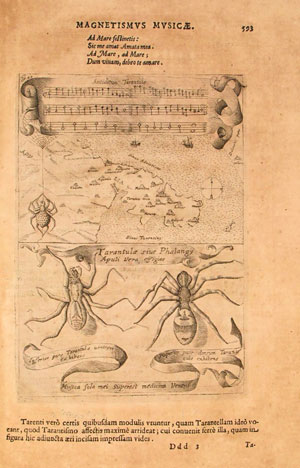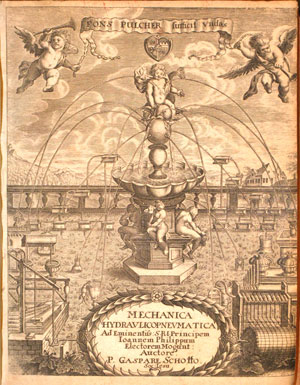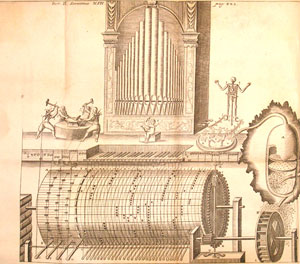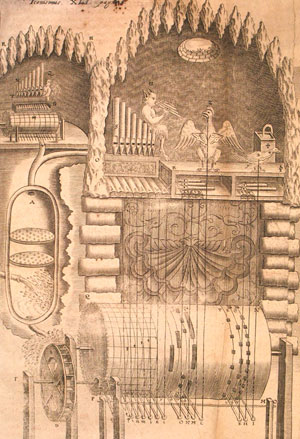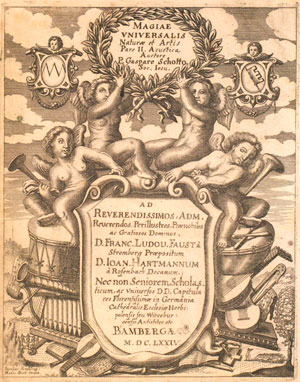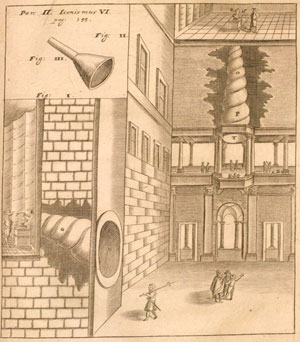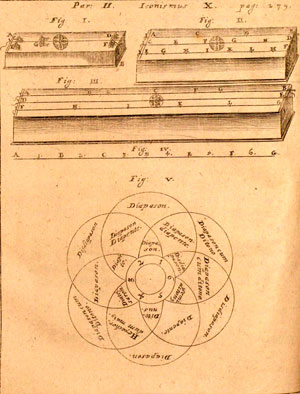Athanasius Kircher (1602–1680) and Gaspar Schott (1608–60)
Music and notions of universal harmony play a prominent part in the extensive published writings of the German Jesuit scholars Athanasius Kircher and his pupil Gaspar Schott. They published on a wide variety of subjects including Egyptology, music theory, geology, mathematics, magnetism, natural history and medicine. Although both sought to disseminate a universal Catholic system of knowledge, their influence extended across all of Europe and beyond. In the theoretical traditions they developed, discussion of what we would now term science combined with Magic as a descriptive category, which at that time remained a legitimate subject for philosophical discourse. Following the example of Fludd, Kircher and Schott's publications are notable for their vivid and extraordinary illustrations of a wide range of phenomena. The Whipple holds all nine of Schott's publications and six of Kircher's 40 published works.
Athanasius Kircher, Magnes sive de arte magnetica (Romae, 1641)
Music's apparent power to affect the mind and body was perceived by Kircher to be magical on account of the fact that it could not be explained adequately in terms of conventional scholastic physics. The Magical therapeutic properties of music are discussed in Magnes sive de arte magnetica where Kircher describes a musical cure for the tarantula's bite.
Gaspar Schott, Mechanica hydraulico-pnevmatica (Frankfurt, 1657)
Kircher's huge collection of natural history specimens, artefacts, and all manner of scientific instruments housed in his Rome museum (Museo Kircheriano) formed the subject matter for Gaspar Schott's first book, Mechanica hydraulico-pnevmatica. As well as a guide to this collection it is important for providing the first detailed account of Guericke's experiments on vacuums (after which Schott became the centre of an international correspondence network on inventions and science). A particularly attractive feature of this book is its 42 full-page engraved plates showing instruments, machines and complicated experiments.
A significant section of Mechanica hydraulico-pnevmatica is devoted to accounts of automated pipe organs, some of them in Kircher's museum. As a symbol of divine order and universal harmony, the organ held an important place in the musical imagery of Kircher and Schott. Kircher had famously portrayed the creation of the world in terms of an organ, each of its six stops representing a day of creation as described in Genesis. Moreover, unusual musical instruments relying on hidden sources of power also invoked the tradition of Magic underlying the musical thinking of Kircher and Schott.
This plate shows the automatic organ in the Quirinal Palace in Rome which had been built in 1598. In addition to playing music, the organ provides a mechanical enactment of Pythagoras visiting the blacksmith's forge.
Also described by Kircher in his Musurgia Universalis, this complex 'Magic' water powered organ presents a nymph and satyr echoing each other in song whilst a cuckoo dances.
Gaspar Schott, Magia universalis naturæ et artis (Bambergæ, 1677)
Schott set out a detailed theoretical and practical account of music and its relation to other areas of knowledge in his Magia universalis naturæ et artis. Whilst retaining a Pythagorean view of music, Schott's belief that the effects and powers of music should be understood through knowledge of 'magical' acoustical phenomena looked in some respects to the new science of acoustics. In this four volume publication, music is covered in the second volume, entitled 'Acustica' (the titles of the other volumes are: 'Optica', 'Mathematica' and 'Physica').
Schott's arrangement of 'Acustica' reveals an Aristotelian distinction between nature and art. The first three books address aspects of sound in general, whilst the remaining four deal with music itself. Each of Acustica's seven books explains a particular branch of Schott's acoustical 'Magic'.
In Liber III, 'Magia Phonotectonica', Schott describes various instruments designed to extend the range of voice and hearing, thereby enabling secret communication at a distance. Like many 17th-century theorists, Schott was fascinated by the material basis of sound. Here he shows statues which seem to talk, as if miraculously. Street noise is conveyed through walls and out of statues' mouths by means of horns and tubing.
In Liber IV 'Magia Musica' Schott deals with divisions and definitions of practical music. For him these were still to be explained mathematically.
Fig. I–IV shows how the mathematical basis for the major scale can be demonstrated by dividing the monochord string into up to 6 equal parts.
Fig. V explains the intervals to be achieved through ratios comprising the numbers 1–6. (Greek interval names are used: Diapason = Octave; Diapente = 5th; Diatesseron = 4th etc.).

